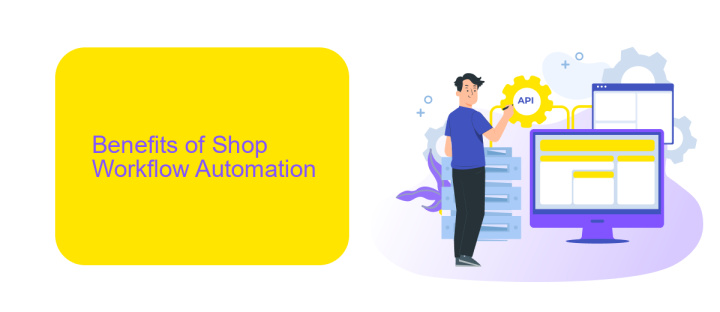Shop Workflow Automation
In today's fast-paced retail environment, shop workflow automation has become essential for maintaining efficiency and competitiveness. By integrating advanced technologies and streamlined processes, businesses can reduce manual tasks, minimize errors, and enhance customer satisfaction. This article explores the key benefits and strategies for implementing shop workflow automation, helping retailers to optimize operations and stay ahead in the market.
Introduction
Shop workflow automation is a critical concept for modern retail businesses aiming to streamline operations and enhance efficiency. By automating routine tasks, shops can focus on delivering exceptional customer experiences and driving sales growth. This process involves integrating various tools and services to ensure seamless operations across different departments.
- Inventory management
- Order processing
- Customer relationship management
- Marketing automation
- Sales analytics
One of the key aspects of shop workflow automation is the integration of different systems to work cohesively. Services like ApiX-Drive offer robust solutions for connecting various applications, enabling data synchronization and process automation. By leveraging such tools, businesses can significantly reduce manual efforts, minimize errors, and ensure that all systems are up-to-date in real-time.
Benefits of Shop Workflow Automation

Automating shop workflows offers numerous benefits, significantly enhancing efficiency and productivity. By automating repetitive tasks, businesses can reduce human error and free up valuable time for employees to focus on more strategic activities. This leads to faster order processing, improved inventory management, and better customer service. Additionally, automation can provide real-time data and analytics, allowing for more informed decision-making and streamlined operations.
Integration of various systems is crucial for effective automation. Services like ApiX-Drive facilitate seamless integration between different platforms, ensuring smooth data flow and communication. This enables shops to synchronize their e-commerce platforms, CRMs, and other tools effortlessly. With ApiX-Drive, businesses can automate data transfers, update inventory levels in real-time, and manage customer information more efficiently. Overall, shop workflow automation not only boosts operational efficiency but also enhances the overall customer experience.
Key Features of Shop Workflow Automation Software

Shop workflow automation software is designed to streamline and optimize the day-to-day operations of retail businesses. These tools help in reducing manual tasks, increasing efficiency, and ensuring a smoother workflow across various departments.
- Task Automation: Automate repetitive tasks such as inventory management, order processing, and customer follow-ups to save time and reduce errors.
- Integration Capabilities: Seamlessly integrate with other software and platforms using services like ApiX-Drive, which simplifies the process of connecting your shop's systems for a unified workflow.
- Real-Time Analytics: Access real-time data and analytics to make informed decisions, monitor performance, and identify areas for improvement.
- Customizable Workflows: Tailor the software to fit your shop's specific needs by customizing workflows, ensuring that all processes align with your business objectives.
- Customer Relationship Management: Enhance customer interactions by managing customer data, tracking purchase history, and automating marketing campaigns.
By leveraging these key features, shop workflow automation software can significantly enhance operational efficiency, reduce costs, and improve overall customer satisfaction. With tools like ApiX-Drive, integrating various systems becomes effortless, further optimizing your shop's workflow.
Implementation and Best Practices

Implementing shop workflow automation requires careful planning and execution to maximize efficiency and minimize disruptions. Begin by assessing your current processes to identify repetitive tasks that can be automated. This will help in selecting the right tools and technologies tailored to your specific needs.
One effective approach is to integrate various systems and platforms used in your shop. Services like ApiX-Drive can facilitate seamless integration between different applications, ensuring data flows smoothly across your workflow. This can significantly reduce manual data entry and errors.
- Identify key processes for automation
- Select appropriate tools and technologies
- Use integration services like ApiX-Drive
- Monitor and adjust automated workflows regularly
Regular monitoring and adjustments are crucial for maintaining an efficient automated workflow. Continuously gather feedback from your team and analyze performance metrics to identify areas for improvement. By following these best practices, you can ensure a smooth transition to an automated shop workflow and achieve long-term success.
- Automate the work of an online store or landing
- Empower through integration
- Don't spend money on programmers and integrators
- Save time by automating routine tasks
Conclusion
In conclusion, shop workflow automation significantly streamlines operations, enhances productivity, and reduces human error. By automating repetitive tasks, businesses can focus more on strategic decision-making and customer satisfaction. This not only leads to increased efficiency but also provides a competitive edge in the market.
Integrating various systems and tools is crucial for a seamless automation process. Services like ApiX-Drive simplify this by enabling easy and efficient integration of multiple applications. With such tools, businesses can ensure that their automated workflows are well-coordinated and effective, ultimately driving growth and success.
FAQ
What is shop workflow automation?
How can I integrate different software tools in my shop?
What are the benefits of automating order processing?
Is it difficult to set up workflow automation in a shop?
Can workflow automation help with customer service?
Apix-Drive will help optimize business processes, save you from a lot of routine tasks and unnecessary costs for automation, attracting additional specialists. Try setting up a free test connection with ApiX-Drive and see for yourself. Now you have to think about where to invest the freed time and money!


